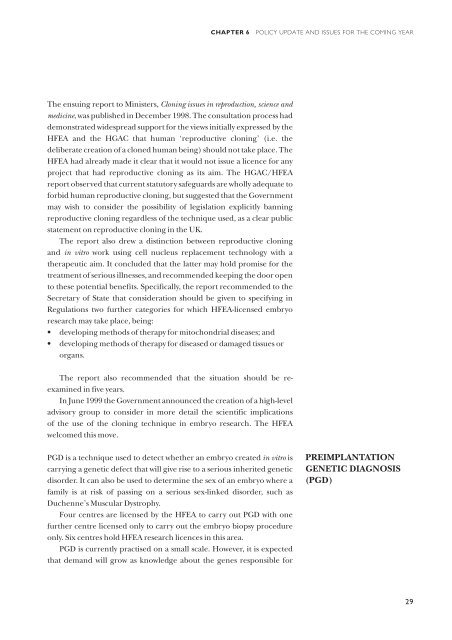HEFA-1999 Part 1/2nd proof - Human Fertilisation & Embryology ...
HEFA-1999 Part 1/2nd proof - Human Fertilisation & Embryology ...
HEFA-1999 Part 1/2nd proof - Human Fertilisation & Embryology ...
Create successful ePaper yourself
Turn your PDF publications into a flip-book with our unique Google optimized e-Paper software.
CHAPTER 6 POLICY UPDATE AND ISSUES FOR THE COMING YEAR<br />
The ensuing report to Ministers, Cloning issues in reproduction, science and<br />
medicine, was published in December 1998. The consultation process had<br />
demonstrated widespread support for the views initially expressed by the<br />
HFEA and the HGAC that human ‘reproductive cloning’ (i.e. the<br />
deliberate creation of a cloned human being) should not take place. The<br />
HFEA had already made it clear that it would not issue a licence for any<br />
project that had reproductive cloning as its aim. The HGAC/HFEA<br />
report observed that current statutory safeguards are wholly adequate to<br />
forbid human reproductive cloning, but suggested that the Government<br />
may wish to consider the possibility of legislation explicitly banning<br />
reproductive cloning regardless of the technique used, as a clear public<br />
statement on reproductive cloning in the UK.<br />
The report also drew a distinction between reproductive cloning<br />
and in vitro work using cell nucleus replacement technology with a<br />
therapeutic aim. It concluded that the latter may hold promise for the<br />
treatment of serious illnesses, and recommended keeping the door open<br />
to these potential benefits. Specifically, the report recommended to the<br />
Secretary of State that consideration should be given to specifying in<br />
Regulations two further categories for which HFEA-licensed embryo<br />
research may take place, being:<br />
• developing methods of therapy for mitochondrial diseases; and<br />
• developing methods of therapy for diseased or damaged tissues or<br />
organs.<br />
The report also recommended that the situation should be reexamined<br />
in five years.<br />
In June <strong>1999</strong> the Government announced the creation of a high-level<br />
advisory group to consider in more detail the scientific implications<br />
of the use of the cloning technique in embryo research. The HFEA<br />
welcomed this move.<br />
PGD is a technique used to detect whether an embryo created in vitro is<br />
carrying a genetic defect that will give rise to a serious inherited genetic<br />
disorder. It can also be used to determine the sex of an embryo where a<br />
family is at risk of passing on a serious sex-linked disorder, such as<br />
Duchenne’s Muscular Dystrophy.<br />
Four centres are licensed by the HFEA to carry out PGD with one<br />
further centre licensed only to carry out the embryo biopsy procedure<br />
only. Six centres hold HFEA research licences in this area.<br />
PGD is currently practised on a small scale. However, it is expected<br />
that demand will grow as knowledge about the genes responsible for<br />
PREIMPLANTATION<br />
GENETIC DIAGNOSIS<br />
(PGD)<br />
29

















